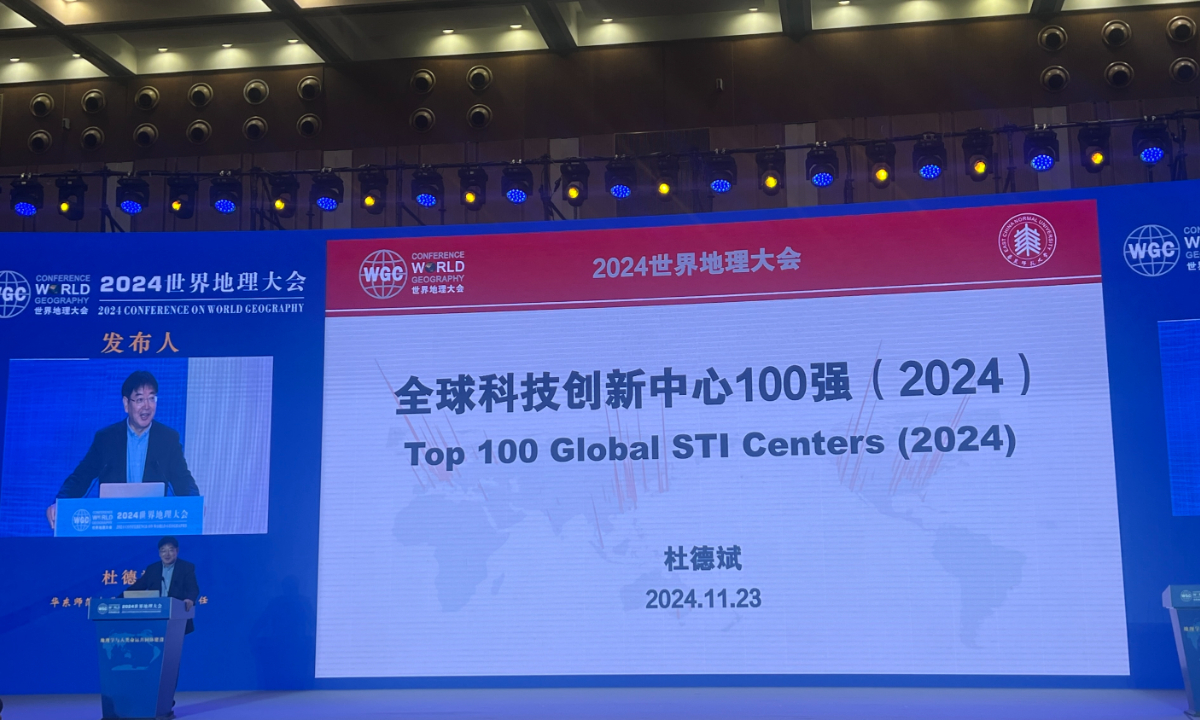
Du Debin, director of the East China Normal University Institute for Global Innovation Studies, delivers the ranking of Top 100 Global Science and Technology Innovation Centers 2024 in Shanghai on November 23, 2024. Photo: Du Qiongfang/GT
With 21 Chinese cities ranking among the 100 most advanced cities in science and technology innovation (STI) globally, China has become one of the two unshakable poles in the global landscape of STI centers only after the US, which has 27 cities listed on the list, according to a recent ranking released on Saturday.
According to the ranking of Top 100 Global STI Centers 2024, released by East China Normal University (ECNU) Institute for Global Innovation Studies (GIS), during the 2024 Conference of World Geography held in Shanghai on Saturday, among the Chinese cities listed, Beijing and Shanghai secured positions in the top 10.
Beijing holds its position as the fourth most advanced city globally and the top city in the Asia-Pacific region, ranking No.1 in the “global leadership of scientific research” category, while Shanghai maintains the 10th position globally and the fourth position in the Asia-Pacific region.
The evaluation system for the Top 100 Global STI Centers assesses the development trends of 140 STI centers worldwide from five dimensions, global clustering abilities of innovation factors, global leadership of scientific research, global original breakthroughs of technological innovation, global driving force of industrial transformation and global support of innovation environment, providing a comprehensive, objective, and accurate reflection of the current state of global STI centers.
According to Du Debin, director of the ECNU Institute for Global Innovation Studies, who led the research and delivered the ranking report, scientific and technological innovation has become the primary battleground of international strategic competition as the world is undergoing accelerated changes unseen in a century, with an increasingly complex international environment and continuous advancements in the new wave of technological revolution and industrial transformation.
Thus, actively addressing the challenges of the times, ensuring national science and technology security, and strategically planning the construction of “global STI centers” have become important measures for countries to cope with the demands of the new technological revolution and enhance their international competitiveness, Du noted.
“By monitoring the development trends of countries around the world since 2022, we expect to provide a reference for the construction of China's STI centers,” Du said.
Based on evaluations across five dimensions, the top 30 global STI centers in the ranking include the San Francisco-San Jose region, New York, London, Beijing, Boston, Tokyo, Paris, Los Angeles, Seoul and Shanghai, Munich, Singapore, Stockholm, Osaka, Hong Kong, Berlin and Amsterdam.
The ranking also shows that the triangle structure of the global STI centers featuring North America, Europe, and the Asia-Pacific as the three poles is becoming increasingly solid. Among the top 100 centers in the comprehensive ranking, 99 are located within these three regions, an increase of four compared with the ranking of 2023, with Sao Paulo in Brazil being the only exception.
Meanwhile, the number of centers in the Asia-Pacific region among the top 100 has reached 35, for the first time exceeding the number in Europe and North America. Europe and North America have 33 and 31 respectively.
The ranking shows that North America and the Asia-Pacific region remain the primary hubs for the world’s leading STI centers. Among the top 30 centers, North America and Asia-Pacific have 13 and 10 centers listed respectively, while Europe has seven cities on the top 30 ranking.
At the national level, China and the US are the two countries with the most STI centers, positioning them as the two dominant poles in the global landscape of science and technology centers.
According to Du, the fierce competition between the top STI centers from China and the US is a major driver of global industrial transformation.
The ranking also shows that China’s STI centers face significant challenges in the areas of clustering innovation factors and fostering an innovation-friendly environment. Particularly, the Chinese centers have seen a significant decline in the dimension of “global clustering abilities of innovation factors” compared with the ranking in 2023, as Beijing dropped out of the top 10, ranking 18th and other cities such as Shanghai, Guangzhou, and Hangzhou also experience varying degrees of decline.
More than 1,000 scholars and experts from across the world engaged in-depth and extensive discussions on the theme of “geography and the building of a community with a shared future for mankind” during the biannual Conference of World Geography held over the weekend.
Apart from the release of the ranking of Top 100 Global STI Centers 2024 at the conference, the first series of books on geography research focusing on country and regional studies was also unveiled. The conference also announced the launch of the compilation of the
Collected Works of Hu Huanyong, a Chinese population geographer who discovered the invisible but important line to mark striking differences in population distribution and urbanization between China's eastern and western regions, and who also for the first time systematically demonstrated that the islands in the South China Sea belong to China and first named them Nansha Qundao (Nansha Islands).




